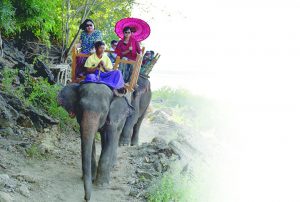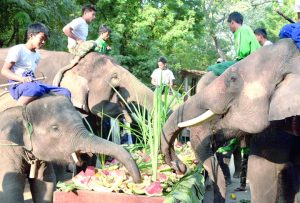22 April
Myanma Timber Enterprise is conserving elephants in a systematic manner when the Ministry of Forestry is promoting ecotourism together with the Ministry of Hotel and Tourism. The elephant is not only of great cultural and historical significance in Myanmar but is also of major economic importance in the country’s timber industry.
Elephant camps are being opened with the aims of cooperating in conversation of elephants, providing job and economic opportunities for nearby people by relying on elephant-based ecotourism, distributing knowledge about elephants, ensuring people to adore and value elephants and becoming recreation center for the travellers from home and abroad. There are a total of 20 elephant camps in Myanmar.
Of them, Palin Kanthayar elephant camp was commissioned into service on 28 March in 2018 with the purpose of implementing elephant-based ecotourism. It is located on the bank of Ayeyawady River, about five miles distant from Nyaung-U on Nyaung-U-Myingyan-Pakokku motor road. There are a total of eight elephants—four are males and another four are females—in the elephant camp. The names of the four male elephants are Zwe Kyaw Lay, Si Tun Maw, Aung Tin Zaw, and Si Tun Bo and those of the four females are Thin Maw, Khin Shu Hmway, Nan Myint Maw and Thwe Shwe Khin.
Elephant ride price for a local people is fixed at Ks 5,000 and a foreigner at Ks 10,000. The elephant ride is five furlongs long and it takes 20 minutes. Animal keepers have to bathe elephants in the mornings and in the evenings. Palin Kanthayar is the top earner with most local and foreign visitors among 20 elephant camps. There are about 100 arrivals every day and more visitors come in the holidays. Sugarcanes, watermelons and maize are the foods of the elephants. There are also elephant food shops. The visitors must pay Ks 1,000 for one tray of elephant food such as sugarcanes, watermelons and maize.
There were 67,856 local and foreign arrivals when the opening of Palin Kanthayar elephant camp was due on 28 March in 2019. The Palin Kanthayar elephant camp received Ks 76,689,000 from camp entrance fee collection and Ks 37,867,000 from elephant rides, according to U Myo Min, an assistant manager of the elephant camp.
The time of bathing elephants is the most favourite leisure hours for foreign tourists. Local travellers prefer to view the beauty of Ayeyawady River from the temporary recreation shelters located in the compound of the elephant camp. Feeding elephant food buffet has been on the increase. Some travellers like buying trays loaded with elephant foods.
Palin Kanthayar elephant camp is always teeming with local and international travellers who are making pilgrimage to Bagan ancient cultural zone. Those who are making pilgrimage to Nyaung-U can perform good deeds by feeding foods to elephants in Palin Kanthayar and can feel the cold and refreshing breezes blowing from the surface of Ayeyawady River during the pilgrimage visit.
Moreover, Palin Kanthayar sandbank recreation site near Palin village in Nyaung-U, Mandalay Region is packed with holidaymakers at a time when Ayeyawady River water is falling. It arranges with the holidaymakers about toddy-palm huts, toddy-palm-made armchairs and bamboo-made armchairs for recreation purpose.
Holidaymakers from Palin Kanthayar elephant camp can take the vehicles owned by Myanma Timber Enterprise to Palin Kanthayar sandbank recreation site. Each passenger costs Ks 500 there and back. Palin Kanthayar sandbank recreation site is located five miles away from Nyaung-U. It can be reached about two furlongs to the bank of Ayeyawady River. It was full of holidaymakers during the days of Thingyan.
Palin Kanthayar elephant camp can create employment for the youths residing nearby villages and has become a thriving center.
Translated by Htut Htut (Twantay)
By Ko Htein (Nga Thayauk)



